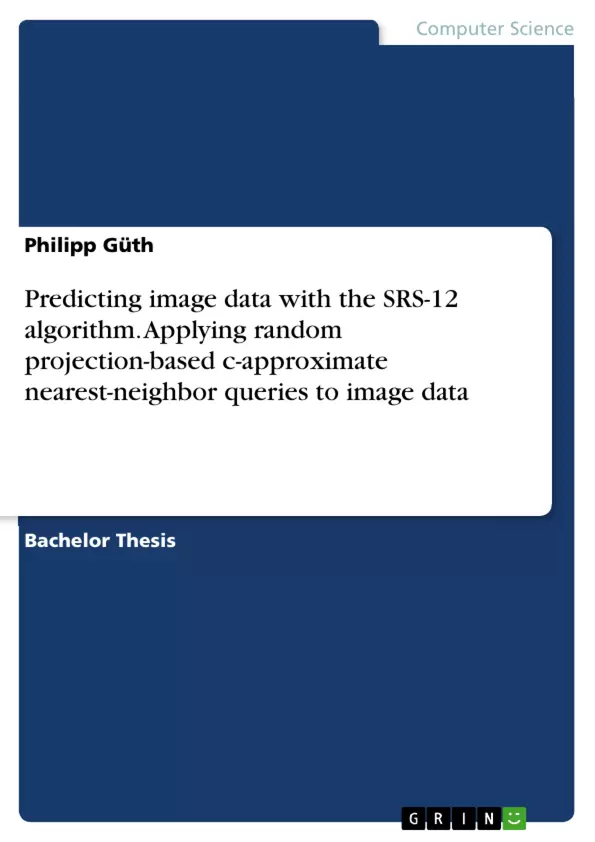Determining point similarity is a cornerstone for a wide variety of applications. Whenever data is being compared, the problem can be stated as a matter of comparing vectors. Due
to this fundamental importance, research has been conducted in this area for decades. For a long time, even for relatively low dimensions such as for example d = 10, complexity was far beyond of what was considered to be feasible in practice. A common approach is to soften the requirements for the accuracy of the neighbor search and look for points within a certain proximity to the query point instead of searching for exact neighbors.
In this thesis we evaluate how well the SRS-12 algorithm works on real-world image data in order to lay the ground for future work such as image prediction. The SRS-12 algorithm is an approach to c-approximate nearest-neighbors and claims to have a tiny index and arbitrary approximation ratio while maintaining good theoretical guarantees.
We first implement and verify the algorithm and subsequently examine the quality of its outputs when it is applied to image data by performing block matching. We find that the SRS-12
algorithm is indeed very suitable for processing image data as long as the input images are cut into patches that are sufficiently large. However the parameters of the algorithm have to be tuned carefully because they significantly affect not only the quality of the results, but also the computation time which can easily exceed an exact nearest-neighbor query if the parameters are not set properly. We conclude our experiment with a recommendation for well-working parameter settings and propose approaches to enhance the quality and speed of approximate nearest-neighbor queries on image data made with the SRS-12 algorithm such that it can be used in real-time.
Inhaltsverzeichnis (Table of Contents)
- Introduction
- Motivation
- Problem Statement
- Objectives
- Structure of this Thesis
- A brief history and overview of Approximate Nearest-Neighbor Queries
- Improving Index Structures
- Softening Requirements for Accuracy
- Further Related Work
- An Introduction to SRS-12
- Why SRS-12 is worth a consideration
- SRS-12 in a Nutshell
- Variants of SRS-12
- Indexing
- Normal Stopping Condition of the SRS-12 Algorithm
- Implementation & Experimental Evaluation
- Implementation Details for the Computation of Parameter Values
- Datasets
- Verification on SIFT1M Dataset
- Block Matching
- A Brief Introduction to Block Matching
- Methodology
- Parameter Settings
- Computation Time
- Conclusions
- Summary - Recommended Parameter Settings
- Computation Time of SRS-12 vs Exact Nearest-Neighbor Search
- Possible Optimizations
- Future Work
- Image Prediction
- Reducing Data through Rapid Object Detection and Background Removal
- Optical Flow
- Increasing the Accuracy of the SRS-12 Algorithm
- Discussion
Zielsetzung und Themenschwerpunkte (Objectives and Key Themes)
This thesis aims to evaluate the performance of the SRS-12 algorithm on real-world image data, laying the groundwork for future research on image prediction. The SRS-12 algorithm is a method for finding approximate nearest neighbors that promises a small index and arbitrary approximation ratios while maintaining good theoretical guarantees.
- The efficiency and effectiveness of the SRS-12 algorithm for image data processing.
- The impact of different parameter settings on the quality and computation time of the algorithm.
- The suitability of SRS-12 for real-time applications.
- Potential optimizations and applications of the algorithm in the field of image prediction.
- The comparison of SRS-12 to traditional nearest-neighbor search methods.
Zusammenfassung der Kapitel (Chapter Summaries)
The introduction presents the motivation behind the thesis, outlining the importance of finding similar points in various scientific and economic applications, particularly in the context of big data. It highlights the challenges associated with traditional nearest-neighbor search methods, especially in high-dimensional spaces. The chapter then introduces the SRS-12 algorithm and its potential benefits in addressing these challenges.
Chapter 2 provides a brief overview of approximate nearest-neighbor queries, exploring different approaches and advancements in index structures, accuracy requirements, and related work. Chapter 3 delves into the SRS-12 algorithm, explaining its core principles, variants, indexing techniques, and stopping conditions.
Chapter 4 focuses on the implementation and experimental evaluation of the SRS-12 algorithm. It details the implementation process, the datasets used, and the verification of the algorithm on the SIFT1M dataset. The chapter further explores the application of SRS-12 in block matching, analyzing the impact of parameter settings, computation time, and overall performance. It concludes by providing recommendations for optimal parameter settings.
Chapter 5 outlines potential future research directions, including the application of SRS-12 to image prediction, data reduction through object detection and background removal, optical flow analysis, and further optimizations to enhance the accuracy of the algorithm.
Schlüsselwörter (Keywords)
This thesis focuses on the SRS-12 algorithm, approximate nearest-neighbor queries, image data processing, block matching, parameter optimization, real-time applications, image prediction, and high-dimensional Euclidean space.
- Quote paper
- Philipp Güth (Author), 2015, Predicting image data with the SRS-12 algorithm. Applying random projection-based c-approximate nearest-neighbor queries to image data, Munich, GRIN Verlag, https://www.grin.com/document/305214



